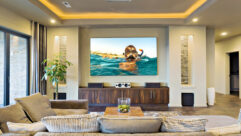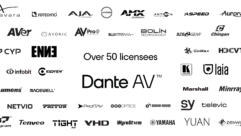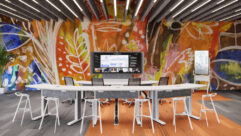Immersive AV Brings WWII Exhibit To Life
The Intrepid Sea-Air-Space Museum uses immersive audio and video systems to recreate a realistic kamikaze attack for visitors.
CHALLENGE: Create an automated AV presentation space onboard the solid steel hangar deck of a vintage WWII aircraft carrier that makes visitors feel like part of the event.
SOLUTION: Use a combination of static acoustical treatments and control technology to monitor and adjust program levels for an automated and immersive multi-screen exhibit.
THE DECK of an aircraft carrier may seem like one of the last places you’d expect to experience a high-quality AV presentation, but that’s exactly what the Intrepid Sea-Air-Space Museum wanted to provide for its visitors. To accomplish this goal, the museum operators enlisted New York-based AV systems integrator VideoSonic to create accurate surround sound synchronized with video playback and lighting in the depths of the U.S.S. Intrepid, a World War II-era aircraft carrier.
The integrator teamed with San Francisco-based consulting firm Auerbach-Pollock-Friedlander Performing Arts/Media Facilities Planning and Design and Watertown, MA-based content producer Chedd-Angier Production Co. to recreate battle scenes for the “Kamikaze: Day of Darkness, Day of Light” exhibit aboard the Intrepid museum, located on Manhattan’s west side piers. Norwalk, CT-based Jaffe Holden Acoustics was also enlisted to provide the critical expertise necessary for acoustical treatments involved in the project.
The U.S.S. Intrepid is the only naval vessel to have suffered two kamikaze attacks in the same day — Nov. 25, 1944. The exhibit is open seven days a week, 10 hours a day, and has about 750,000 visitors each year. Through the creative use of multiple projection screens and surround sound audio, the program captures the intense, visceral story of a fireman who lost his life that day and a surviving gunner’s mate.
MIXING ONSITE
Aboard the U.S.S. Intrepid, New York-based systems integrator VideoSonic was tasked with the logistical challenge of creating a multi-channel program in an exhibit space located more than 400 feet from the equipment room. To properly and accurately mix the immersive audio program for the “Kamikaze: Day of Darkness, Day of Light” exhibit, VideoSonic set out to do the mix-down in the hangar deck space.
The integrator rented a Digidesign Pro Tools HD system to match the one Watertown, MA-based content producer Chedd-Angier Production Co. used in its post facility and placed a Mackie SDR24 hard disk recorder and a Biamp 24-input AudiaFLEX chassis at the mix position. The Mackie unit was put into source mode and connected to Pro Tools via ADAT light pipe cables.
With this configuration, the AudiaFLEX system and CobraNet chassis allowed VideoSonic to patch into an “AV point” through a single Cat5 cable and make a crosspatch in the equipment room downstairs. Once the mix-down was completed, VideoSonic permanently installed both the AudiaFLEX chassis and the Mackie hard disk recorder in the same rack in the equipment room.
“We might have been able to rent a 200-foot snake and run it through the corridors and stairways down to our amplifier rack in the equipment room, but I’m glad we didn’t,” says Dennis Flood, CTO of VideoSonic. “During initial system engineering, we settled on two CobraNet chasses just to accommodate the number of inputs and outputs required. Yet by locating the SDR24 and the input AudiaFLEX chassis at the mix position and patching into one of our Cat5 cables, we discovered an application for the CobraNet connection that was never originally envisioned and was accomplished almost by accident.”
Visitors in Intrepid Hall, one of four main galleries on the hangar deck, stand in the very spot where the fireman lost his life in the second attack. This concept puts viewers in the center of the action, but also placed a number of unique demands on the system and the design team. Intrepid Hall is a 20,000-square-foot space with a solid steel floor and a 22-foot ceiling — hardly an acoustician’s dream location. Directly above lies executive offices and quarters, which required that noise transmission was kept to a minimum. And because the vessel had to be kept in its original form, the projectors, screens, and surround sound speakers had to be hung above the hangar deck without any ceiling modification.
“On top of that, the entire system had to be automated,” says Glenn Polly, owner of VideoSonic. “This program runs once an hour on the half hour, and everything from the automation to the sound processing had to be flawless.”
At the heart of the audio system is a Biamp AudiaFLEX system, which controls a unique 13.1 sound system (five screen channels, eight “surround” channels, and a subwoofer). The AudiaFLEX controls the multi-channel playback from a Mackie SDR24 24-track digital recorder, executing cross-fades between the discrete channels while a VideoSonic VIDS server provides eight channels of high-bitrate MPEG video. SMPTE time code on one of the video channels provides the master clock that the lighting controller and 24-channel audio player chase to maintain frame-accurate synchronization for the show. Strategically positioned behind five display screens,13 Bag End T1200 speakers are powered through two Biamp MCA8150 amplifiers, while a single Bag End Quartz-I subwoofer (with four 18-inch woofers) is powered by a Crown MA3600 amplifier.
“We used Biamp AudiaFLEX because we knew that the complexity of the program and the acoustic challenges provided by the space required a powerful, flexible solution for re-configuring and tuning the system,” Polly says. “In retrospect, the audio production would not have been possible without it.”
Polly says the unusual physical characteristics of the space coupled with the complexity of the multi-channel audio program, dictated that the show wouldn’t be mixed in a controlled studio, but in the actual space onboard the Intrepid (see sidebar). The AudiaFLEX units, the VideoSonic video server, and other components are housed in three Middle Atlantic MRK- 3726 racks located below the hangar deck in a climate-controlled room that also hosts the ship’s IT gear.
Acoustical challenges
Back on the hangar deck where the show takes place, VideoSonic also faced some unique acoustical problems. One primary challenge called for reducing a high ambient noise level created by the ship’s massive air handling systems. Polly says the design team used custom acoustical panels from Kinetics Noise Control to reduce the reverberant reflections of sound in the room. On the ceiling, VideoSonic installed 2-inch-thick Kinetics Hardside Acoustical Panels, which are wrapped in Guilford of Maine fabric that matches the ivory colored interior paint of the ship, making them virtually unnoticeable to visitors. These ceiling panels prevent sound from the exhibit from permeating into executive offices located directly above it.
Yet the team’s most ingenious solution involved controlling the ambient noise at the source. Working with HVAC supplier Carrier Corp., Polly and his team discovered industrial-grade variable speed drives made by Toshiba that would effectively ramp down the air handling motors during show times upon receiving automated commands from the VIDS server. The Toshiba model H7 adjustable frequency drive units reduce motor speeds, resulting in approximately 10 dB of noise attenuation during shows at a cost of around $5,000 for four drives on the four air handling units.
Another set of custom-made panels was also installed along the vertical, sloped surface of the hangar deck using 4-inch-thick Kinetics KNP Series perforated, galvanized steel panels. All of these treatments greatly reduced the ambient noise floor in the exhibit area and helped to create the required isolation between the Kamikaze exhibit and the other exhibit halls.
Another unique feature of the show uses the ambient noise level sensing functions of AudiaFLEX. Two Audio-Technica microphones are suspended from the ceiling to “listen” to the ambient noise level created by the varying audience size. The signal from the mics are input to the AudiaFLEX, and depending on the SPL thresholds measured, the system will self-adjust to one of three volume presets with a 6-dB range from the lowest to the highest level.
Immersive video
The exhibit’s images appear on five Draper Targa screens, positioned in an arc measuring about 90 degrees long. The center image is a 9- by 12-foot screen, flanked on either side by a vertically oriented 6- by 4-foot screen. On each side of these screens is another 7-foot-tall by 10-foot-wide screen. All of the screens can be monitored in the control room on a Marshall Electronics V-R25P LCD rack monitor’s 10 2.5-inch active matrix LCD panels.
Five Sanyo XP46 video projectors suspended from the ceiling project discrete content delivered by the VIDS server. In conjunction with the speakers, the projectors can provide a single audio and video channel with an actor narrating some of the events of that day, black and white, archived news footage, or 360 degrees of fire and smoke, along with the screams of the wounded and the explosions from igniting fuel tanks in full surround sound, shaking the aircraft carrier’s deck. Projected images can span across the entire screen montage as well as on individual screens.
FOR MORE INFORMATION
- Audio-Technicawww.audio-technica.com
- Bag Endwww.bagend.com
- Biampwww.biamp.com
- Crownwww.crownaudio.com
- Digidesignwww.digidesign.com
- Draperwww.draperinc.com
- Guilford of Mainewww.guilfordofmaine.com
- Kinetics Noise Controlwww.kineticsnoise.com
- Mackiewww.mackie.com
- Marshall Electronicswww.lcdracks.com
- Middle Atlanticwww.middleatlantic.com
- Sanyowww.sanyo.com
- Toshiba Industrialwww.tic.toshiba.com
Although the AV system was originally budgeted at $300,000 prior to installation, Polly’s team found ways to conserve costs while also providing for future expansion. “We invited the museum’s IT department to ‘share’ the AV control room space, as the location they previously occupied was less than ideal for a server room,” Polly says. “But the real intent had to do with our goal to provide future proofing. Having their T1 lines and network located in the same room as the AV system can provide future opportunities for people to visit the museum over the Internet and support distance learning programs that could enable teachers to log in to view her students’ activities after a class visit to the museum.”
AV system costs totaled less than $200,000, including equipment, programming, installation, and build out of the control room. The Kamikaze exhibit is a powerful buildup to a climactic battle scene that shows how the crew pulled together to survive, keeping the ship in the fleet for one of the biggest battles of the Pacific. The end-result is a successful implementation in a difficult environment that executes an entertaining and moving multimedia display.
Tim Wetmore is a freelance writer based in New York. He has extensive experience in writing for the AV industry. He can be reached at[email protected]










